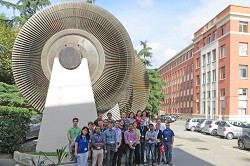Better gas turbine engine designs boost efficiency and cut noise
Gas turbine engines - used for electricity generation and in domestic boilers for heating buildings - have become greener over recent years. This was made possible by mixing fuel with an excess of air before burning it, resulting in lower flame temperatures and reduced emission of pollutants. However, this pollution-cutting technology is prone to ‘combustion instabilities’ which can lead to high noise levels and sometimes damage to engines. Scientists working under the EU-funded TANGO (Thermoacoustic and Aeroacoustic Nonlinearities in Green combustors with Orifice structures) project have worked on ways to overcome these instabilities. ‘Within TANGO’s research we wanted to understand the thermoacoustic and aeroacoustic interactions in combustion systems like gas turbine engines and domestic boilers that play a key role in combustion instabilities,’ says Maria Heckl, TANGO project coordinator. Combustion instabilities can trigger intense pressure vibrations within the engine. These can then cause excessive structural vibrations, fatigue of certain engine components and even catastrophic damage to combustor hardware. ‘There is an urgent need to understand the physical processes that are responsible so that methods to predict and prevent these instabilities can be developed,’ Heckl says. In a bid to advance this field, the project developed an early warning system capable of detecting the oscillations associated with combustion instabilities well before they reach dangerously high levels. The early warning system has now been patented and is marketed by TANGO partner IfTA under the name ‘IfTA PreCursor’. In a second line of enquiry, the project aimed to avoid these instabilities specifically in domestic boilers, which typically have a heat exchanger in the combustion chamber. The researchers developed theoretical models, which not only demonstrate that a heat exchanger with carefully chosen properties can suppress instability, but which also serve as a tool to predict the optimal settings for that heat exchanger. Heckl now expects Bekaert – one TANGO project partner – to use these models to create a new generation of instability-proof and quiet domestic boilers. The project also advanced scientific knowledge on other aspects, for example how do micro-perforated plates interact with sound waves, and can they be used to reduce noise levels during a combustion instability? In addition, the project also focussed on gender equality in science. Four out of the 15 fellows were female and all fellows were trained on gender awareness. TANGO has published its results in many papers in scientific journals and at international conferences. The project expects its results to be taken up by scientists tackling specific research questions. Even though the project has now ended, Heckl is aiming to keep the research going. ‘TANGO was very successful and a joy to coordinate. I now hope to set up a similar project to deepen our understanding of aeroacoustics and contribute to work reducing environmental noise. I will also continue my efforts to attract more women to engineering science,’ she concludes.
Keywords
TANGO, combustion instabilities, gas turbines, engines, boilers, energy efficiency, noise, electricity generators







